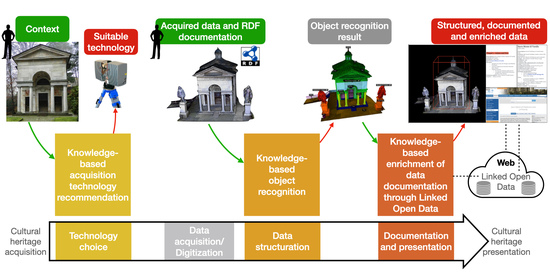From Acquisition to Presentation—The Potential of Semantics to Support the Safeguard of Cultural Heritage
Abstract
:1. Introduction
- Data acquisition guided by a recommendation system for acquisition technologies.
- Data processing and structuring through knowledge-guided object recognition.
- Data presentation with cultural information thanks to an enrichment process from Linked Open Data.
1.1. Challenges
- Data acquisition, which allows the digitization of a cultural object and produces unstructured data;
- Data processing, which produces a structured data thanks to the segmentation, classification, and analysis of unstructured data;
- Data enrichment, which consists of enriching the structured data with cultural heritage information and knowledge related to the structured data;
- Data presentation, which allows the visualization of the structured and enriched data.
1.2. Related Work
2. Method
- Cultural heritage acquisition.
- Data processing to structure it by recognizing objects.
- Enrichment from Linked Open Data to share and present cultural heritage.
2.1. Knowledge Modeling
- Knowledge related to physical objects and their history;
- Knowledge related to digitized objects and their associated process of digitization;
- Knowledge related to the processing of digitized objects to recognize them and structure the data.
2.2. Recommendation of Acquisition Technologies
- The first step consists of determining the requirement of data for an optimal input according to a user’s application context.
- The second step consists of determining the most suitable acquisition technologies according to data requirements and characteristics of objects targeted by the user application.
- The third step consists of computing parameters according to data and objects feature.
2.3. Object Recognition
2.4. Object Enrichment with Cultural Heritage Information
3. Materials
3.1. Case Studies
3.1.1. Terrace House 2 of Ephesos
3.1.2. First Chapel of the Sacro Monte in Varallo, Italy
3.2. Object Modeling Related to the Case Studies
3.2.1. Watermill of the Ephesos Terrace House 2
3.2.2. First Chapel of Sacro Monte
4. Results
4.1. Recommendation of Acquisition Technologies
4.2. Object Recognition Results
4.2.1. Result of Watermill Recognition in Ephesos Terrace House 2
4.2.2. Results of the Sacro Monte First Chapel
- GetHeight: characterizes the height of a segment.
- GetWidth: characterizes the width of a segment.
- GetLength: characterizes the length of a segment.
- GetVolume: characterizes the volume of a segment.
- GetArea: characterizes the area of a segment.
- GetLocation: characterizes the location of a segment.
- GetMeanNormal: characterizes the mean normal of a segment.
- GetPointCount: characterizes the point number of a segment.
- GetMeanColor: characterizes the mean color of a segment.
- GetResolution: characterizes the resolution of a segment.
- GetDistance: characterizes the Euclidean distance between two segments.
- GetAltitude: characterizes the altitude of a segment.
- GetDistance: characterizes the Euclidean distance between two segments.
- isParallele: characterizes the parallelism between two segments.
- isBetween: characterizes segments for which their position is between two other segments.
- isAligned: characterizes segments that align with other segments.
4.3. Object Enrichment Results
4.3.1. Ephesos Terrace House 2
4.3.2. First Chapel of Sacro Monte
5. Discussion
5.1. Recommended Acquisition Technology Discussion
5.2. Object Recognition Discussion
5.2.1. Discussion on Watermill Recognition in Ephesos Terrace House 2
5.2.2. Discussion on the First Chapel of Sacro Monte
5.3. Object Enrichment Discussion
6. Conclusions
Author Contributions
Funding
Institutional Review Board Statement
Informed Consent Statement
Data Availability Statement
Acknowledgments
Conflicts of Interest
Abbreviations
| KnowDIP | Knowledge-based Detection in Image and Point cloud |
| COSCH | Colour and Space in Cultural Heritage |
| COSCH-KR | COSCH Knowledge Representation |
| TLS | Terrestrial Laser Scanner |
| CH | Cultural Heritage |
| BIM | Building Information Modeling |
| HBIM | Heritage Building Information Modeling |
| RDF | Resource Description Framework |
| OWL | Web Ontology Language |
| CIDOC-CRM | Conceptual Reference Model |
| CNN | convolutional neural network |
References
- Yang, F.; Xu, F.; Zhang, K.; Bu, X.; Hu, H.; Anokye, M. Characterisation of Terrain Variations of an Underwater Ancient Town in Qiandao Lake. Remote Sens. 2020, 12, 268. [Google Scholar] [CrossRef] [Green Version]
- Janowski, L.; Kubacka, M.; Pydyn, A.; Popek, M.; Gajewski, L. From acoustics to underwater archaeology: Deep investigation of a shallow lake using high-resolution hydroacoustics—The case of Lake Lednica, Poland. Archaeometry 2021. [Google Scholar] [CrossRef]
- Majcher, J.; Quinn, R.; Plets, R.; Coughlan, M.; McGonigle, C.; Sacchetti, F.; Westley, K. Spatial and temporal variability in geomorphic change at tidally influenced shipwreck sites: The use of time-lapse multibeam data for the assessment of site formation processes. Geoarchaeology 2021, 36, 429–454. [Google Scholar] [CrossRef]
- Coburn, E.; Light, R.; McKenna, G.; Stein, R.; Vitzthum, A. LIDO-lightweight information describing objects version 1.0. In Proceedings of the ICOM International Committee of Museums, Shanghai, China, 7–12 November 2010. [Google Scholar]
- Heritage, M. The UK Historic Environment Data Standard. 2012. Available online: https://historicengland.org.uk/images-books/publications/midas-heritage/midas-heritage-2012-v1_1/ (accessed on 18 March 2021).
- Berners-Lee, T.; Hendler, J.; Lassila, O. The semantic web. Sci. Am. 2001, 284, 34–43. [Google Scholar] [CrossRef]
- Singh, M.P.; Huhns, M.N. Web Ontology Language: OWL. In Service-Oriented Computing; Springer: Berlin/Heidelberg, Germany, 2006; pp. 137–162. [Google Scholar] [CrossRef]
- Omerovic, S.; Milutinovic, V.; Tomazic, S. Concepts, Ontologies, and Knowledge Representation; Springer: Berlin/Heidelberg, Germany, 2001. [Google Scholar]
- Doerr, M. The CIDOC Conceptual Reference Module: An Ontological Approach to Semantic Interoperability of Metadata. AI Mag. 2003, 24, 75. [Google Scholar] [CrossRef]
- Pieraccini, M.; Guidi, G.; Atzeni, C. 3D digitizing of cultural heritage. J. Cult. Herit. 2001, 2, 63–70. [Google Scholar] [CrossRef]
- Omar, T.; Nehdi, M.L. Data acquisition technologies for construction progress tracking. Autom. Constr. 2016, 70, 143–155. [Google Scholar] [CrossRef]
- Boochs, F.; Bentkowska-Kafel, A.; Degrigny, C.; Karaszewski, M.; Karmacharya, A.; Kato, Z.; Picollo, M.; Sitnik, R.; Trémeau, A.; Tsiafaki, D.; et al. Colour and Space in Cultural Heritage: Interdisciplinary Approaches to Documentation of Material Culture. Int. J. Herit. Digit. Era 2014, 3, 713–730. [Google Scholar] [CrossRef]
- Karmacharya, A.; Wefers, S. Structuring spectral and spatial recording strategies of cultural heritage assets. Background, state of affairs, and future perspectives. In Digital Techniques for Documenting and Preserving Cultural Heritage. Collection Development, Cultural Heritage and Digital Humanities; Arc Humanities Press: Ghent, Belgium, 2017; pp. 157–172. [Google Scholar]
- Grilli, E.; Menna, F.; Remondino, F. A review of point clouds segmentation and classification algorithms. In Proceedings of the International Archives of the Photogrammetry, Remote Sensing and Spatial Information Sciences—ISPRS Archives, Nafplio, Greece, 1–3 March 2017; Volume 42, pp. 339–344. [Google Scholar] [CrossRef] [Green Version]
- Fang, H.; Lafarge, F.; Pan, C.; Huang, H. Floorplan generation from 3D point clouds: A space partitioning approach. ISPRS J. Photogramm. Remote Sens. 2021, 175, 44–55. [Google Scholar] [CrossRef]
- Anguelov, D.; Taskar, B.; Chatalbashev, V.; Koller, D.; Gupta, D.; Heitz, G.; Ng, A. Discriminative learning of Markov random fields for segmentation of 3D scan data. In Proceedings of the 2005 IEEE Computer Society Conference on Computer Vision and Pattern Recognition, CVPR 2005, San Diego, CA, USA, 20–25 June 2005; Volume II, pp. 169–176. [Google Scholar] [CrossRef] [Green Version]
- Triebel, R.; Schmidt, R.; Mozos, O.M.; Burgard, W. Instance-based AMN classification for improved object recognition in 2D and 3D laser range data. In IJCAI International Joint Conference on Artificial Intelligence; Morgan Kaufmann Publishers Inc.: San Francisco, CA, USA, 2007; pp. 2225–2230. [Google Scholar]
- Lawin, F.J.; Danelljan, M.; Tosteberg, P.; Bhat, G.; Khan, F.S.; Felsberg, M. Deep projective 3D semantic segmentation. In Lecture Notes in Computer Science (Including Subseries Lecture Notes in Artificial Intelligence and Lecture Notes in Bioinformatics); Springer International Publishing: Cham, Switzerland, 2017; pp. 95–107. [Google Scholar] [CrossRef] [Green Version]
- Shelhamer, E.; Long, J.; Darrell, T. Fully Convolutional Networks for Semantic Segmentation. IEEE Trans. Pattern Anal. Mach. Intell. 2017, 39, 640–651. [Google Scholar] [CrossRef] [PubMed]
- Nguyen, A.; Le, B. 3D point cloud segmentation: A survey. In Proceedings of the 2013 6th IEEE Conference on Robotics, Automation and Mechatronics (RAM), Manila, Philippines, 12–15 November 2013; pp. 225–230. [Google Scholar]
- Qi, C.R.; Yi, L.; Su, H.; Guibas, L.J. PointNet++: Deep hierarchical feature learning on point sets in a metric space. Adv. Neural Inf. Process. Syst. 2017, 30, 5100–5109. [Google Scholar]
- Guo, Y.; Wang, H.; Hu, Q.; Liu, H.; Liu, L.; Bennamoun, M. Deep learning for 3D point clouds: A survey. IEEE Trans. Pattern Anal. Mach. Intell. 2019, 1. [Google Scholar] [CrossRef]
- Torralba, A.; Murphy, K.P.; Freeman, W.T. Using the forest to see the trees: Exploiting context for visual object detection and localization. Commun. ACM 2010, 53, 107–114. [Google Scholar] [CrossRef] [Green Version]
- Hoiem, D.; Efros, A.A.; Hebert, M. Geometric context from a single image. In Proceedings of the IEEE International Conference on Computer Vision, Beijing, China, 17–21 October 2005; Volume I, pp. 654–661. [Google Scholar] [CrossRef]
- De Luca, L. 3D Modelling and Semantic Enrichment in Cultural Heritage. Photogrammetric Week’13; Fritsch, D., Ed.; Wichmann/VDE Verlag: Berlin, Germany, 2013; pp. 323–333. [Google Scholar]
- Markhoff, B.; Nguyen, T.B.; Niang, C. When It Comes to Querying Semantic Cultural Heritage Data. In New Trends in Databases and Information Systems; Kirikova, M., Nørvåg, K., Papadopoulos, G.A., Gamper, J., Wrembel, R., Darmont, J., Rizzi, S., Eds.; Springer International Publishing: Cham, Switzerland, 2017; pp. 384–394. [Google Scholar]
- Garozzo, R.; Murabito, F.; Santagati, C.; Pino, C.; Spampinato, C. CulTO: An ontology-based annotation tool for data curation in cultural heritage. Int. Arch. Photogramm. Remote Sens. Spat. Inf. Sci. 2017, 42, 267–274. [Google Scholar] [CrossRef] [Green Version]
- Durand, N.; Derivaux, S.; Forestier, G.; Wemmert, C.; Gançarski, P.; Boussaïd, O.; Puissant, A. Ontology-based object recognition for remote sensing image interpretation. In Proceedings of the International Conference on Tools with Artificial Intelligence, ICTAI, Patras, Greece, 29–31 October 2007; Volume 1, pp. 472–479. [Google Scholar] [CrossRef] [Green Version]
- Maillot, N.; Thonnat, M.; Hudelot, C. Ontology based object learning and recognition: Application to image retrieval. In Proceedings of the International Conference on Tools with Artificial Intelligence, ICTAI, Boca Raton, FL, USA, 15–17 November 2004; pp. 620–625. [Google Scholar] [CrossRef]
- Ponciano, J.J.; Boochs, F.; Trémeau, A. Knowledge-based object recognition in point clouds and image data sets. GIS Sci. Die Z. Fur Geoinform. 2017, 3, 97–104. [Google Scholar]
- Ponciano, J.J.; Roetner, M.; Reiterer, A.; Boochs, F. Object Semantic Segmentation in Point Clouds—Comparison of a Deep Learning and a Knowledge-Based Method. ISPRS Int. J. Geo-Inf. 2021, 10, 256. [Google Scholar] [CrossRef]
- Georgiadis, H.; Papanoti, A.; Paschou, M.; Roubani, A.; Hardouveli, D.; Sachini, E. The semantic enrichment strategy for types, chronologies and historical periods in searchculture. gr. In Research Conference on Metadata and Semantics Research; Springer: Berlin/Heidelberg, Germany, 2017; pp. 211–223. [Google Scholar]
- Vlachidis, A.; Bikakis, A.; Kyriaki-Manessi, D.; Triantafyllou, I.; Padfield, J.; Kontiza, K. Semantic representation and enrichment of cultural heritage information for fostering reinterpretation and reflection on the European history. In Digital Cultural Heritage; Springer: Berlin/Heidelberg, Germany, 2018; pp. 91–103. [Google Scholar]
- Munnelly, G.; Lawless, S. Constructing a knowledge base for entity linking on Irish cultural heritage collections. Procedia Comput. Sci. 2018, 137, 199–210. [Google Scholar] [CrossRef]
- Munnelly, G.; Pandit, H.J.; Lawless, S. Exploring linked data for the automatic enrichment of historical archives. In European Semantic Web Conference; Springer: Berlin/Heidelberg, Germany, 2018; pp. 423–433. [Google Scholar]
- Mouromtsev, D.; Haase, P.; Cherny, E.; Pavlov, D.; Andreev, A.; Spiridonova, A. Towards the Russian linked culture cloud: Data enrichment and publishing. In European Semantic Web Conference; Springer: Berlin/Heidelberg, Germany, 2015; pp. 637–651. [Google Scholar]
- Maietti, F.; Di Giulio, R.; Piaia, E.; Medici, M.; Ferrari, F. Enhancing Heritage fruition through 3D semantic modelling and digital tools: The INCEPTION project. In Proceedings of the IOP Conference Series: Materials Science and Engineering, Florence, Italy, 16–18 May 2018; IOP Publishing Ltd.: Bristol, UK; Volume 364, p. 012089. [Google Scholar]
- Maietti, F.; Medici, M.; Ferrari, F.; Ziri, A.E.; Bonsma, P. Digital cultural heritage: Semantic enrichment and modelling in BIM environment. In Digital Cultural Heritage; Springer: Berlin/Heidelberg, Germany, 2018; pp. 104–118. [Google Scholar]
- Quattrini, R.; Pierdicca, R.; Morbidoni, C. Knowledge-based data enrichment for HBIM: Exploring high-quality models using the semantic-web. J. Cult. Herit. 2017, 28, 129–139. [Google Scholar] [CrossRef]
- Ponciano, J.J. Object Detection in Unstructured 3D Data Sets Using Explicit Semantics. Ph.D. Thesis, University of Lyon, Lyon, France, 2019. [Google Scholar]
- Ponciano, J.J.; Trémeau, A.; Boochs, F. Automatic detection of objects in 3D point clouds based on exclusively semantic guided processes. ISPRS Int. J. Geo-Inf. 2019, 8, 442. [Google Scholar] [CrossRef] [Green Version]
- Petras, V.; Hill, T.; Stiller, J.; Gäde, M. Europeana—A search engine for digitised cultural heritage material. Datenbank Spektrum 2017, 17, 41–46. [Google Scholar] [CrossRef]
- Wefers, S. Die Mühlenkaskade von Ephesos. Technikgeschichtliche Studien zur Versorgung Einer Spätantiken bis Frühbyzantinischen Stadt, 1st ed.; Monographien RGZM, Verlag des RGZM: Mainz, Germany, 2015; Volume 118. [Google Scholar]
- Matrone, F.; Lingua, A.; Pierdicca, R.; Malinverni, E.S.; Paolanti, M.; Grilli, E.; Remondino, F.; Murtiyoso, A.; Landes, T. A benchmark for large-scale heritage point cloud semantic segmentation. Int. Arch. Photogramm. Remote Sens. Spat. Inf. Sci. 2020, XLIII-B2-2020, 1419–1426. [Google Scholar] [CrossRef]
- Ponciano, J.J.; Karmacharya, A.; Wefers, S.; Atorf, P.; Boochs, F. Connected Semantic Concepts as a Base for Optimal Recording and Computer-Based Modelling of Cultural Heritage Objects. In Structural Analysis of Historical Constructions; Springer International Publishing: Cham, Switzerland, 2019; pp. 297–304. [Google Scholar]
- Ponciano, J.J.; Boochs, F.; Trémeau, A. 3D object recognition through a process based on semantics and consideration of the context. In Photogrammetrie, Laserscanning, Optische 3D-Messtechnik, Beiträge der Oldenburger 3D-Tage 2020; Wichmann: Oldenburger, Germany, 2020. [Google Scholar]
- Ponciano, J.J.; Boochs, F.; Tremeau, A. Identification and classification of objects in 3D point clouds based on a semantic concept. In Oldenburger 3D-Tage 2019; Wichmann: Oldenburger, Germany, 2019; pp. 98–106. [Google Scholar]
- Poux, F.; Mattes, C.; Kobbelt, L. Unsupervised segmentation of indoor 3d point cloud: Application to object-based classification. Int. Arch. Photogramm. Remote Sens. Spat. Inf. Sci. 2020, XLIV-4/W1-2020, 111–118. [Google Scholar] [CrossRef]
- Vo, A.V.; Truong-Hong, L.; Laefer, D.F.; Bertolotto, M. Octree-based region growing for point cloud segmentation. ISPRS J. Photogramm. Remote Sens. 2015, 104, 88–100. [Google Scholar] [CrossRef]
- Wefers, S.; Cramer, A. Dissemination Design of a 3D Documented Archaeological Feature in Ephesos. COSCH e-Bull. 2014, 1, 1–11. [Google Scholar]
- Poux, F.; Ponciano, J.J. Self-learning ontology for instance segmentation of 3d indoor point cloud. ISPRS Int. Arch. Photogramm. Remote Sens. Spat. Inf. Sci. 2020. [Google Scholar] [CrossRef]
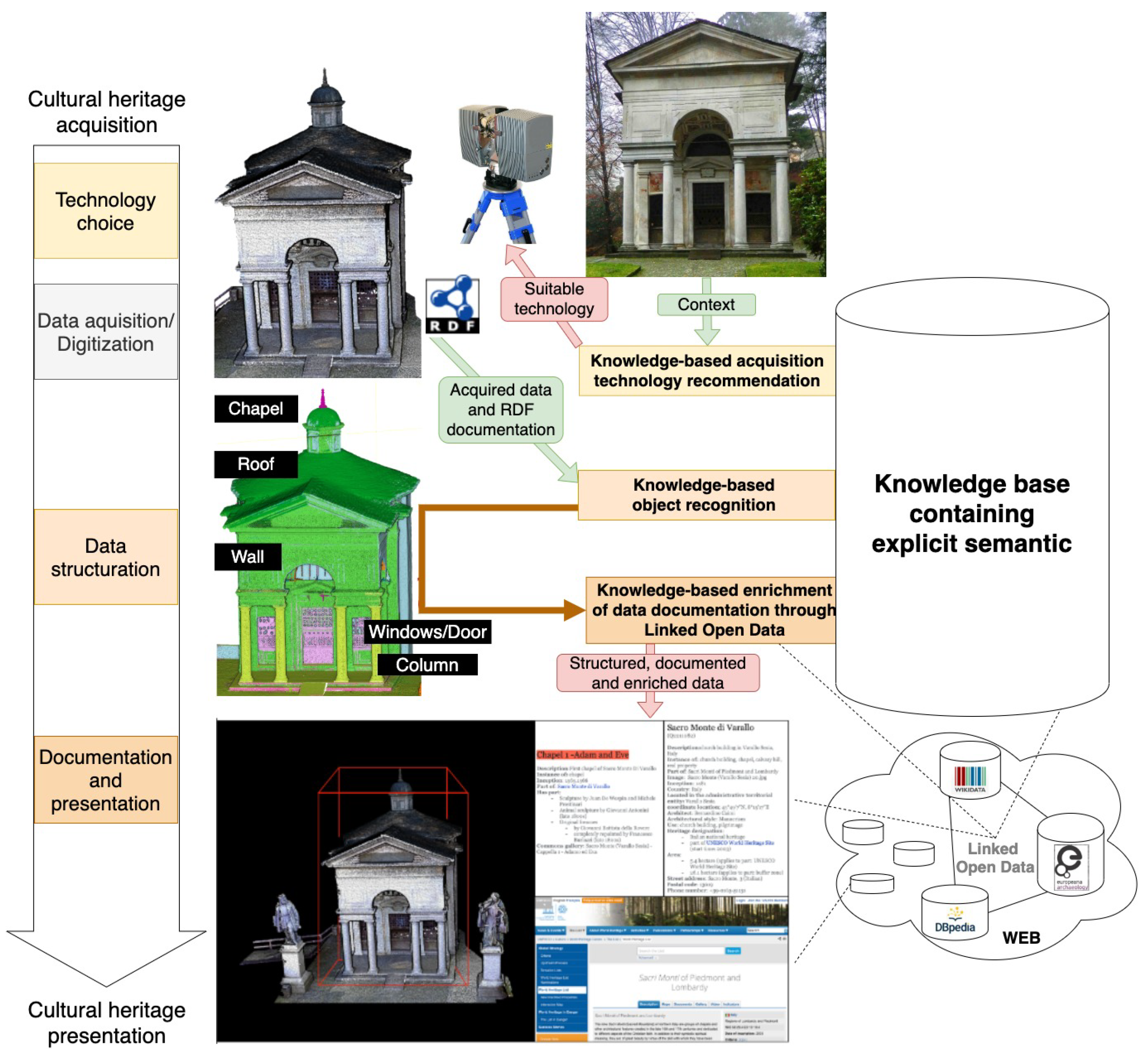
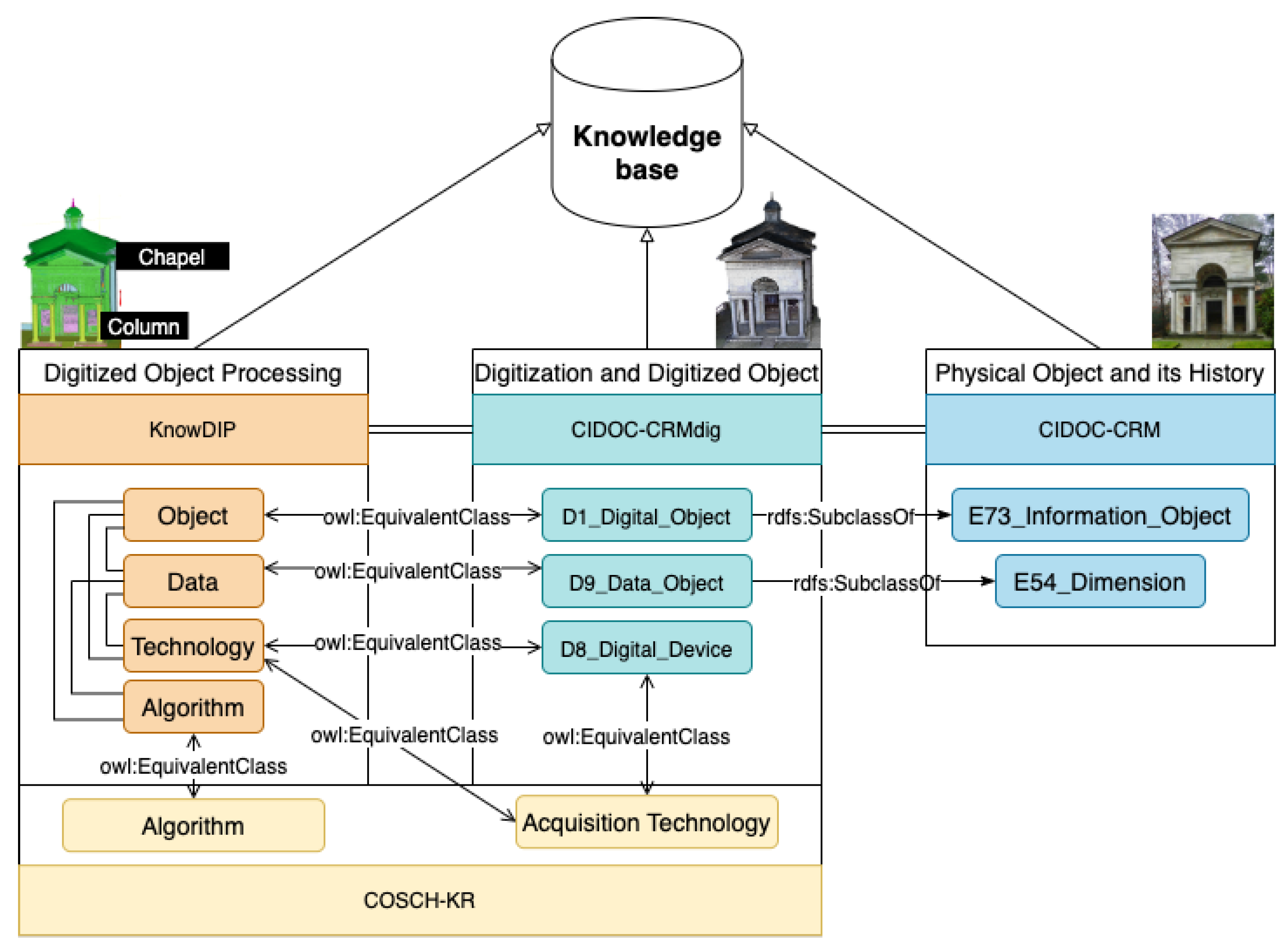

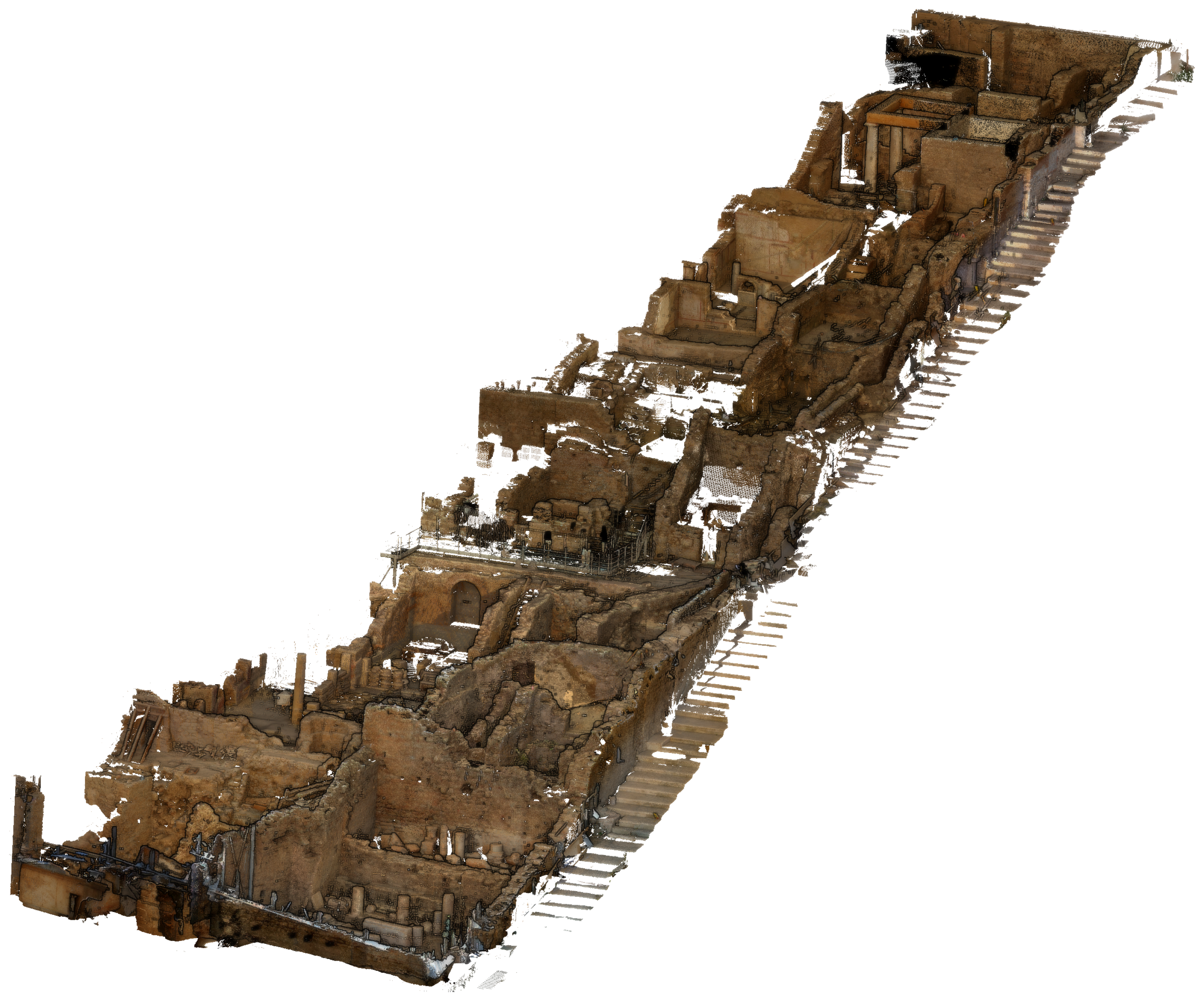

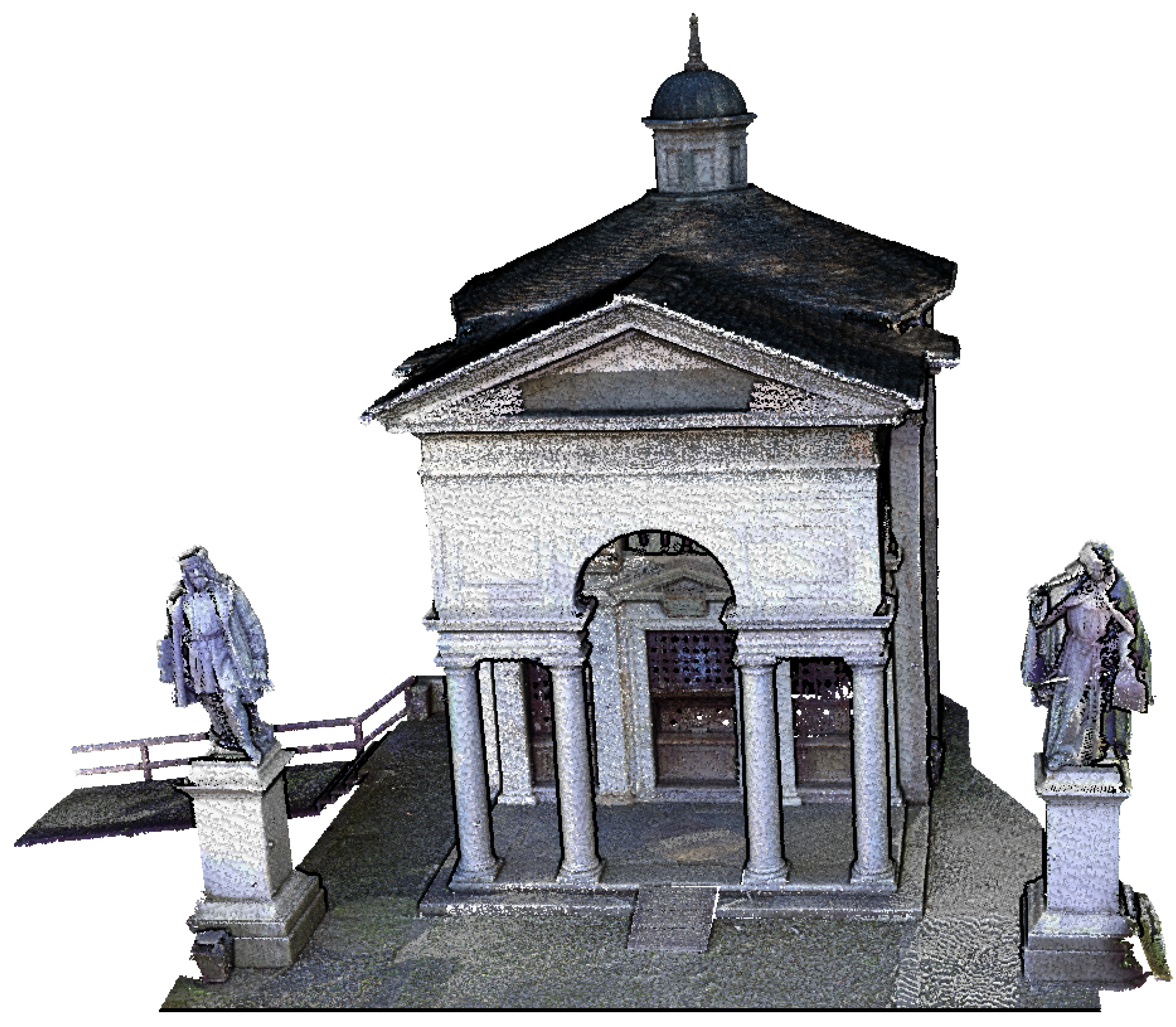
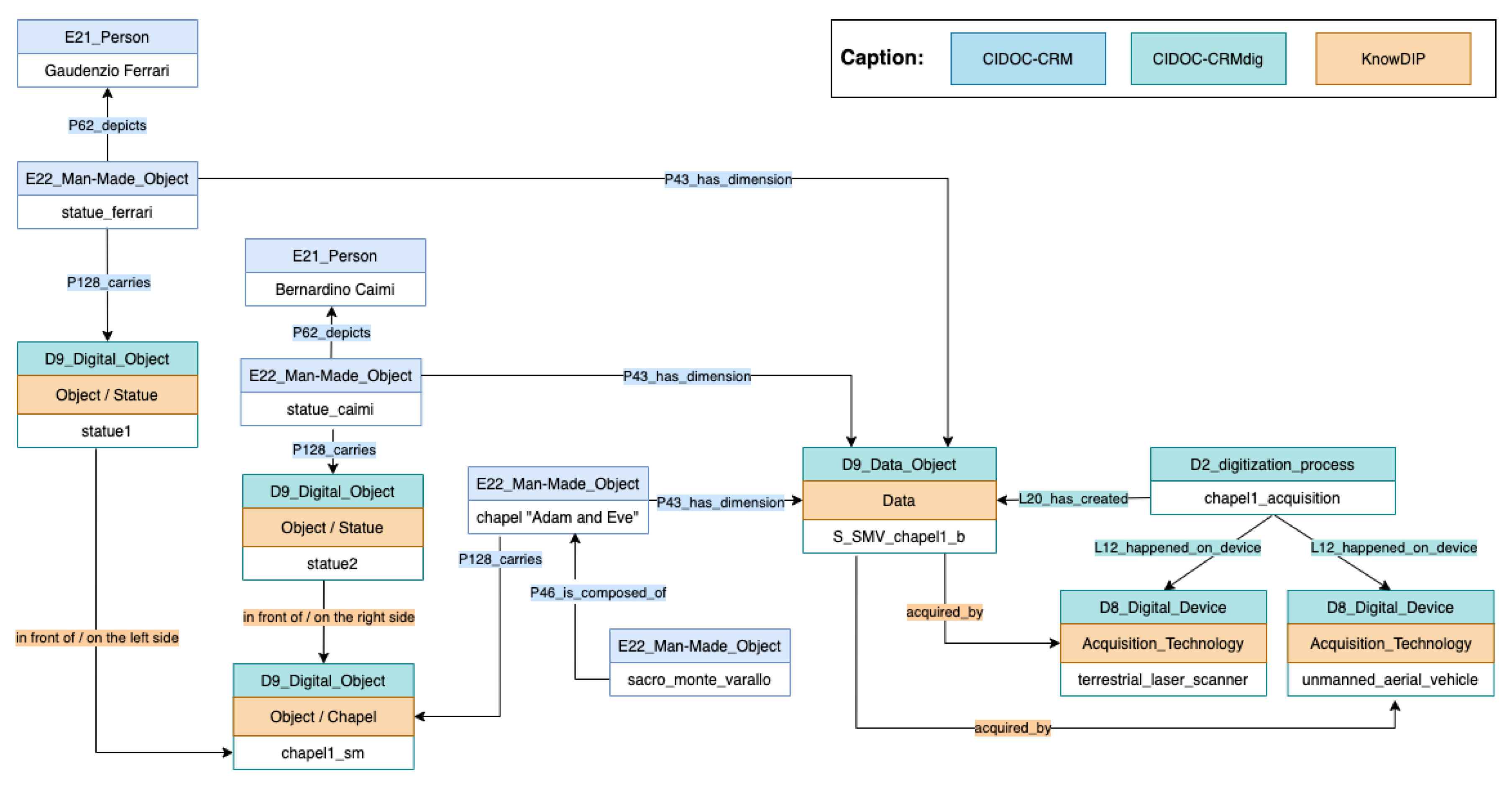
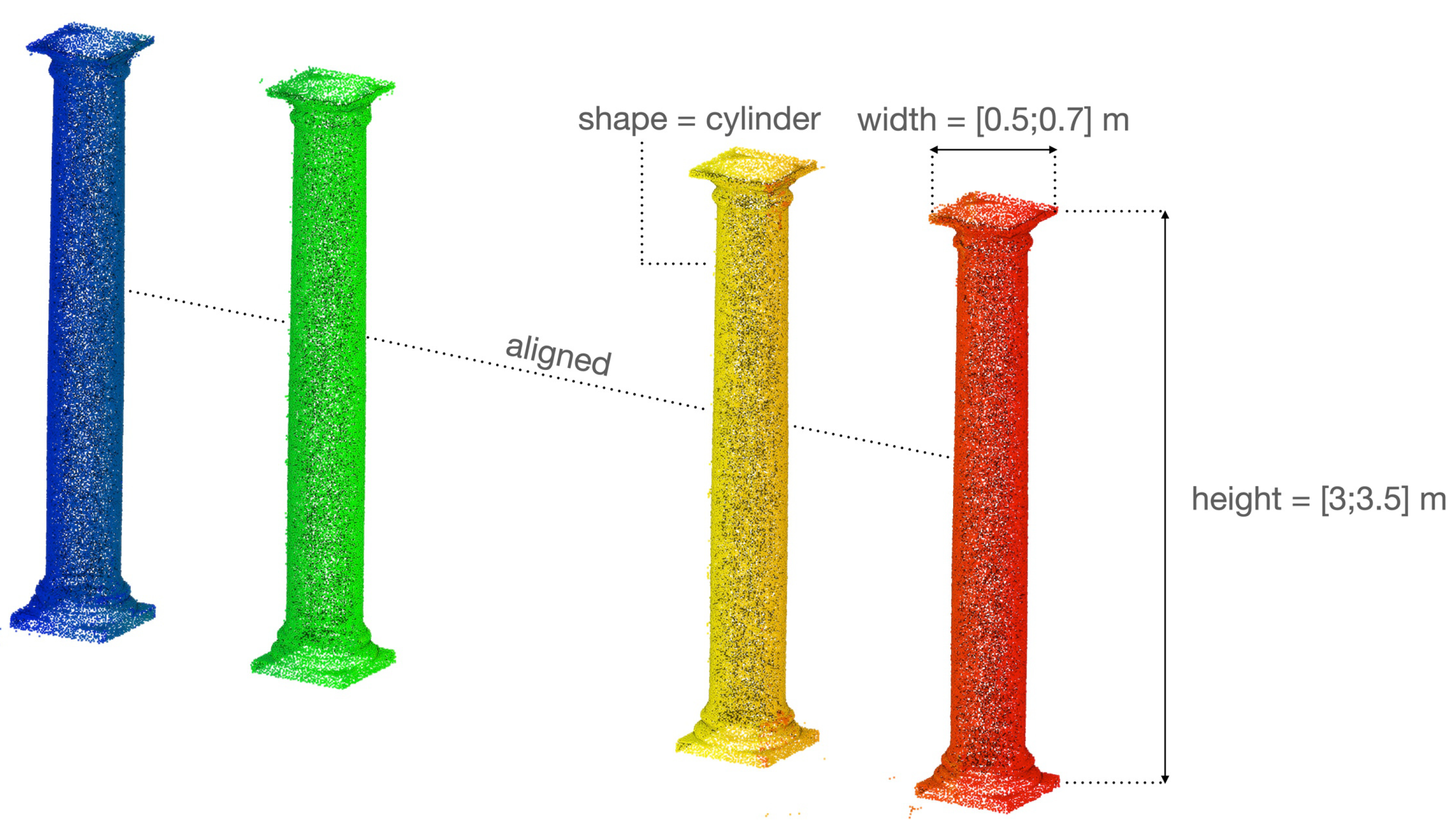

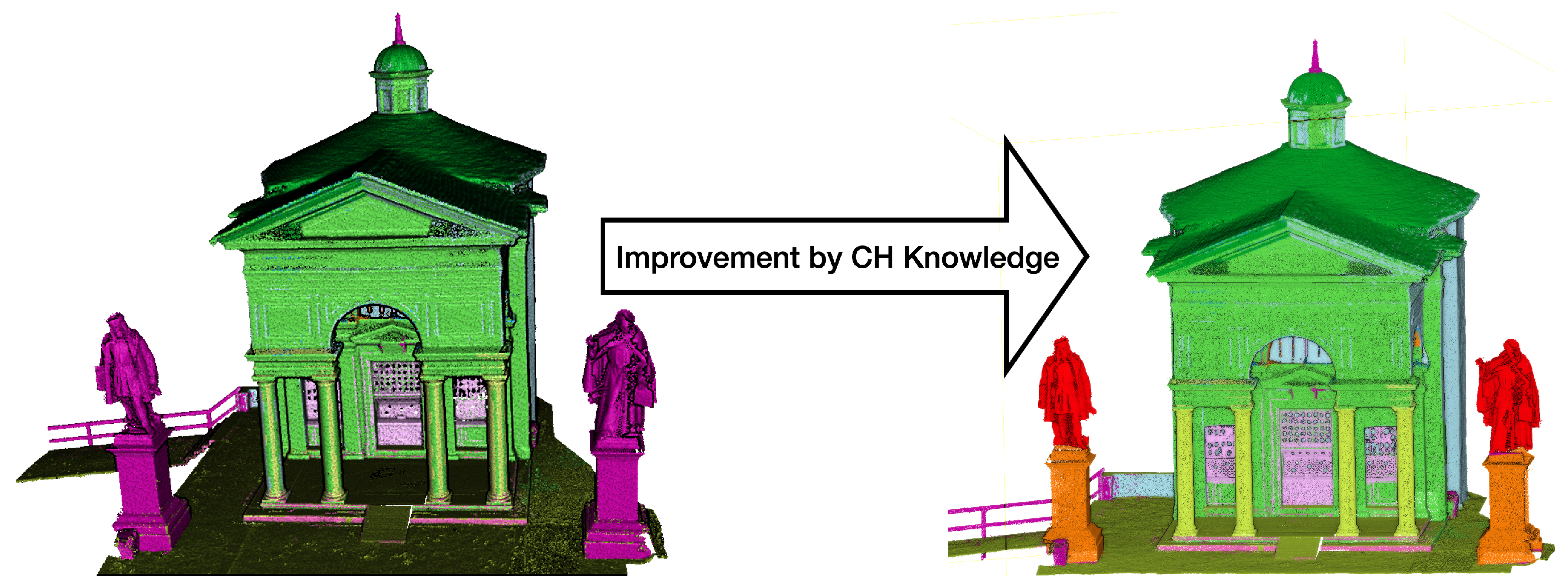


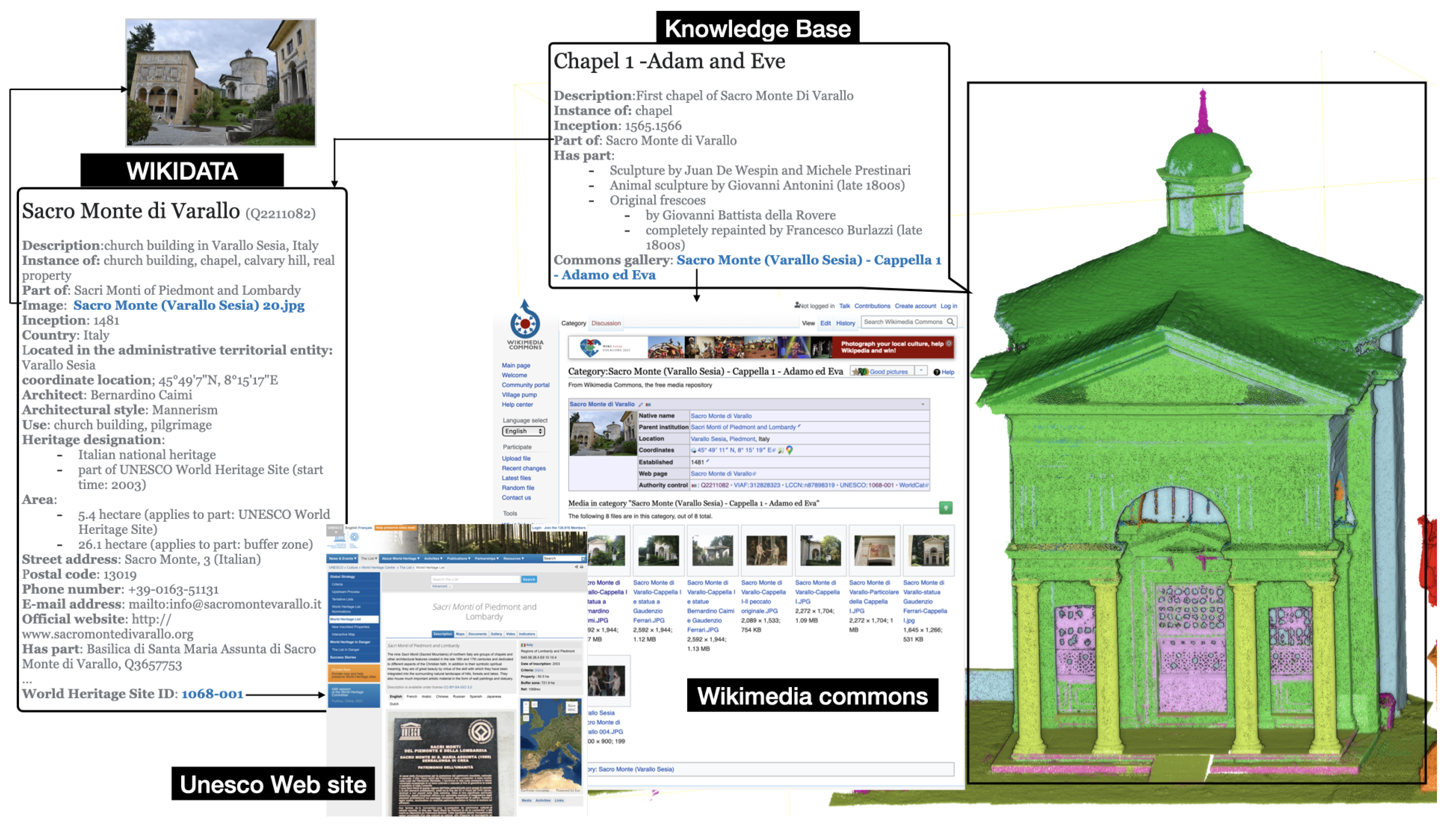

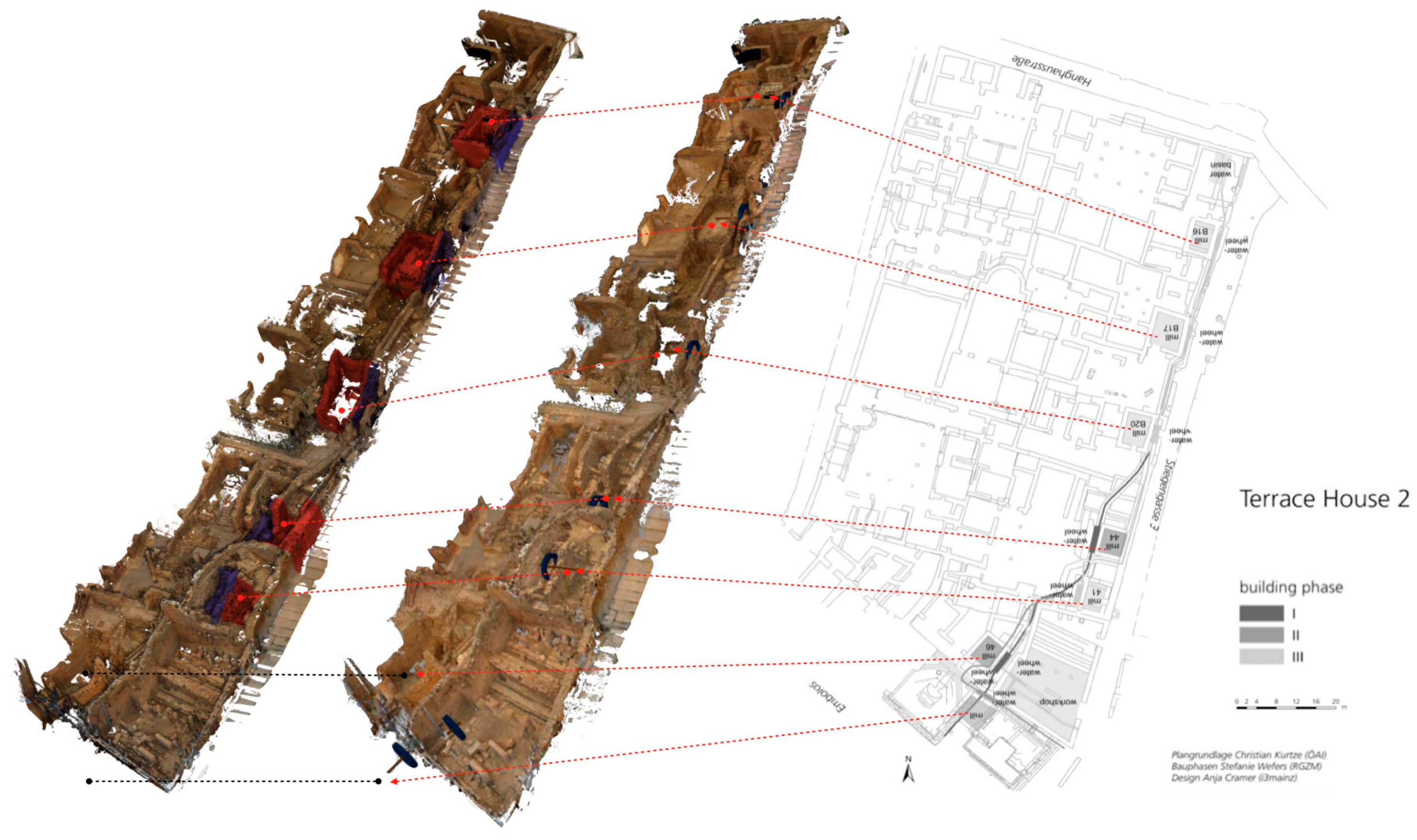
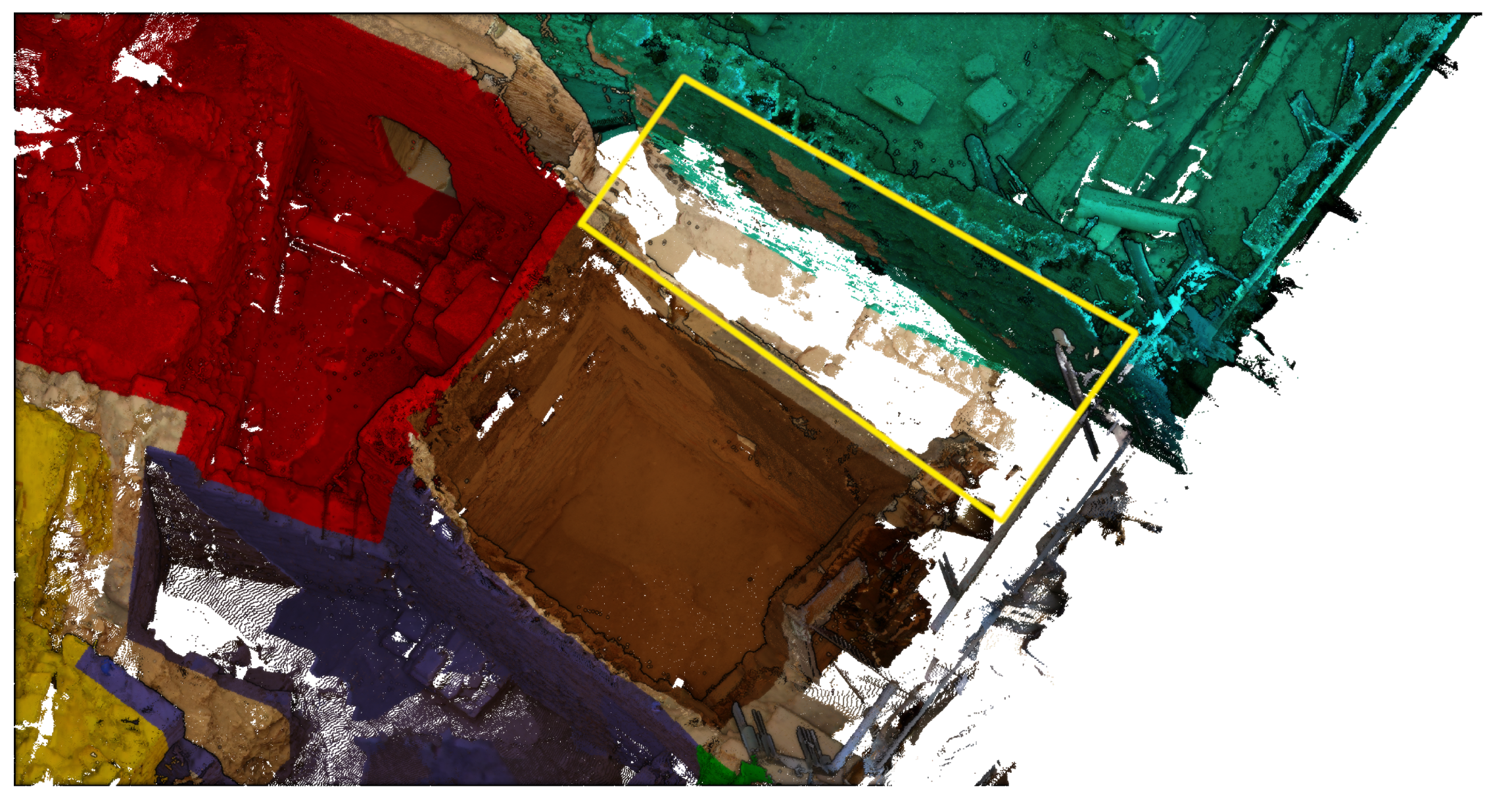
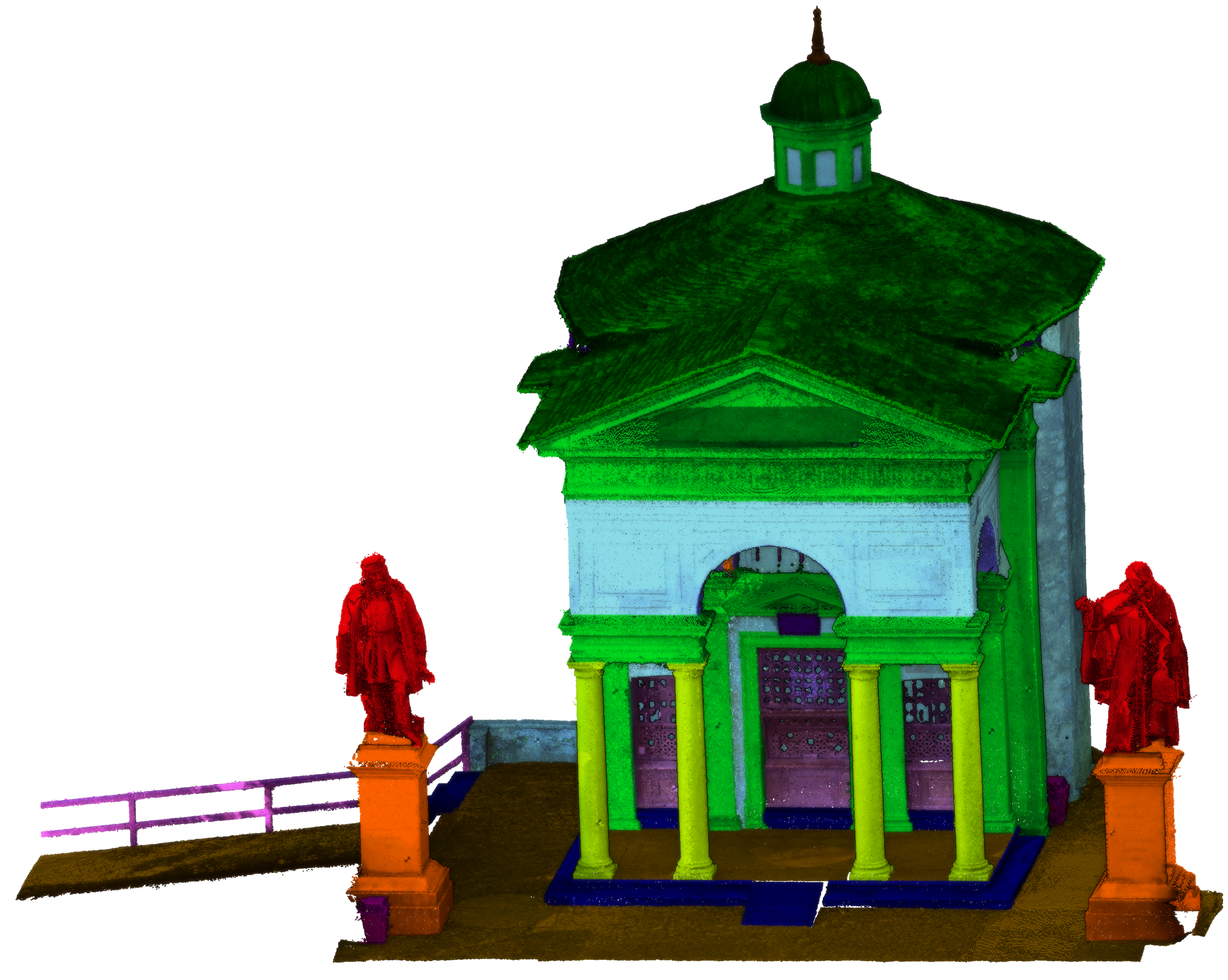

| Class (Index Code) | F1 Score | IoU | Precision | Recall |
|---|---|---|---|---|
| Column (1) | 0.981 | 0.963 | 0.999 | 0.963 |
| Stairs (6) | 0.382 | 0.236 | 0.779 | 0.253 |
| Floor (3) | 0.903 | 0.823 | 0.835 | 0.983 |
| Moldings (2) | 0.682 | 0.517 | 0.691 | 0.673 |
| Other (9) | 0.872 | 0.773 | 0.965 | 0.796 |
| Wall (5) | 0.867 | 0.765 | 0.846 | 0.888 |
| Door/Window (4) | 0.801 | 0.668 | 0.821 | 0.782 |
| Roof (8) | 0.880 | 0.786 | 0.875 | 0.885 |
| Vault (7) | 0.728 | 0.572 | 0.704 | 0.753 |
| Arch(0) | 0.341 | 0.205 | 0.492 | 0.261 |
| Total | 0.833 | 0.715 | 0.833 | 0.833 |
Publisher’s Note: MDPI stays neutral with regard to jurisdictional claims in published maps and institutional affiliations. |
© 2021 by the authors. Licensee MDPI, Basel, Switzerland. This article is an open access article distributed under the terms and conditions of the Creative Commons Attribution (CC BY) license (https://creativecommons.org/licenses/by/4.0/).
Share and Cite
Ponciano, J.-J.; Prudhomme, C.; Boochs, F. From Acquisition to Presentation—The Potential of Semantics to Support the Safeguard of Cultural Heritage. Remote Sens. 2021, 13, 2226. https://0-doi-org.brum.beds.ac.uk/10.3390/rs13112226
Ponciano J-J, Prudhomme C, Boochs F. From Acquisition to Presentation—The Potential of Semantics to Support the Safeguard of Cultural Heritage. Remote Sensing. 2021; 13(11):2226. https://0-doi-org.brum.beds.ac.uk/10.3390/rs13112226
Chicago/Turabian StylePonciano, Jean-Jacques, Claire Prudhomme, and Frank Boochs. 2021. "From Acquisition to Presentation—The Potential of Semantics to Support the Safeguard of Cultural Heritage" Remote Sensing 13, no. 11: 2226. https://0-doi-org.brum.beds.ac.uk/10.3390/rs13112226







